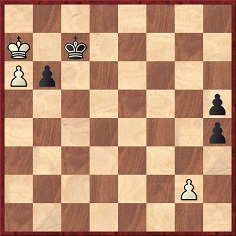
Edward Winter
From page 13 of the 5/1982 issue of the SSKK Bulletinen:

The position is labelled ‘Wagner-Dührssen, 1927’. Clearly White’s only hope is stalemate, so: 1 g4 h3 2 g5 h2 3 g6
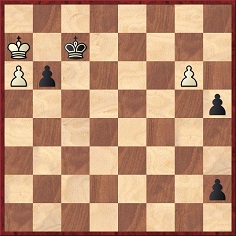
3...h1(B).(Only a bishop will do. A knight would naturally be much too far away to accomplish anything, while if 3...h1(Q) or (R) then 4 g7 Q/Rg1 5 g8(Q) Q/Rxg8 stalemate.) 4 g7 Bd5 5 g8(Q) Bxg8 6 Ka8 Bc4 7 White resigns.
Can anyone supply the full game-score? We should like to be reassured that this did all occur in an actual game.
(298)
C.N. 298 asked whether an attractive piece of underpromotion did occur in a genuine game. The answer is now available: no: Page 213 of the July 1928 Wiener Schachzeitung gives the last 14 moves of the game between A. Wagner of Stanislau [today: Ivano-Frankivsk, Ukraine] and Dr R. Dührssen of Berlin in the Wiener Schachzeitung Fernturnier, Group XVI, April-November 1927:
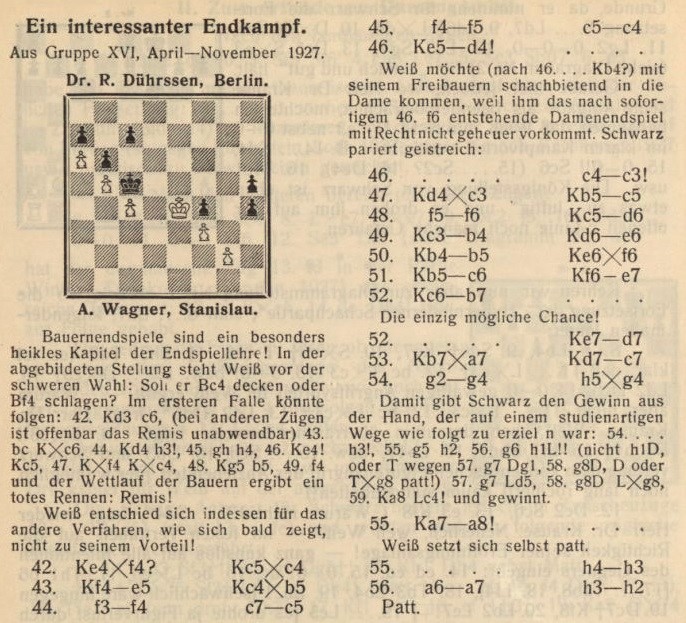
After 53 Kxa7 Kc7 the position in C.N. 298 was reached, and the bishop underpromotion line is given in a note to Black’s 54th move.
(699)
The position below is taken from page 12 of the January 1909 Wiener Schachzeitung. It occurred in a simultaneous exhibition (+ 21 –2 =6) between F.J. Marshall and Dr Hartlaub in Hamburg on 15 December 1908.
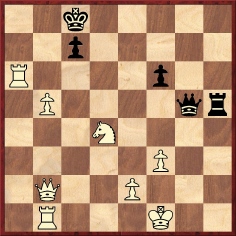
Marshall won with 1 Ra8+ Kb7 2 Ra7+ Kb6 3 Ra6+ Kb7 4 e3 Rh1+ 5 Ke2 Rh2+ 6 Kd3 Rxb2 7 Rxb2 c5 8 bxc6+ Kxa6 9 c7 Qf5+ 10 Nxf5 Ka7 11 c8(R) Resigns.
Is it possible to find the complete game-score in a newspaper of the time?
(354)
A position on page 61 of volume one of Schachtaktik by Erwin Voellmy (Basle, 1927):
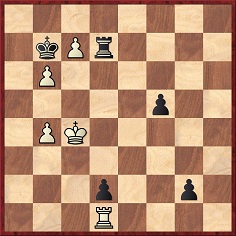
White to move
The players and occasion were not stated (apart from ‘Sept. 1912’). White won by 1 Ra1 d1(Q) 2 Ra7+ Kxb6 3 c8(N)+ Kc6 4 b5 mate.
(2015)
From page 105 of La Stratégie, March 1913:
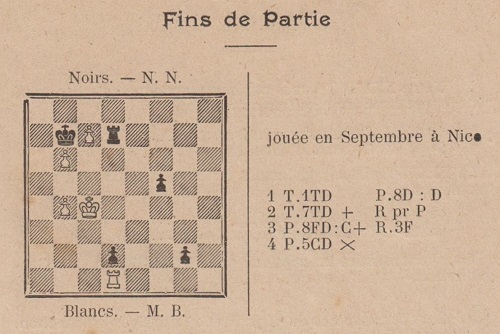
(2460)
On page 176 of Chess Curiosities (London, 1985) Tim Krabbé quoted a position from a USSR correspondence game (Babushkin v Postnikov, 1969-70) featuring what was claimed to be ‘the only knighting on record that was not a check’. We note that the game between Xiu Jun and Vassily Ivanchuk in the 1993 World Team Championship in Lucerne (won by Black in 62 moves) began: 1 d4 d5 2 c4 e6 3 Nf3 dxc4 4 Qa4+ Nd7 5 e4 Nf6 6 Nc3 a6 7 Bxc4 Rb8 8 Qc2 b5 9 Be2 Bb7 10 O-O b4 11 e5 bxc3 12 exf6 cxb2 13 fxg7
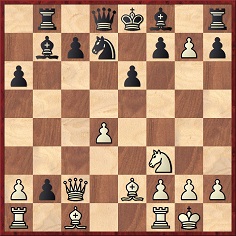
13… bxal(N).
(2016)
Antonio Gude (Madrid) sends this position from a game between Michael Adams and Tony Miles at Tilburg on 17 November 1993:

White played 90 b8(N), and according to the tournament bulletin the game was drawn at move 122. However, Tony Miles (Birmingham, England) informs us:
‘It was actually drawn around move 135, but neither the players nor the computer monitor could keep track during the final time scramble.’
(2031)
Alain Pallier (Avignon, France) offers a further example. The position below occurred at the end of the game between Najdorf and Schweber at Buenos Aires, 1968:

Black having just moved 63...Na6-c5, White played 64 b8(N), and the game was declared drawn.
Source: Shakhmatny Byulletin, 1/1969, page 32.
(2043)
Two further specimens have come from Alain Pallier:
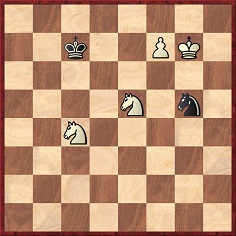
Vujic v Petrovic, Yugoslav Ladies’ Championship, Kula, 1985
White played 74 f8(N) and won at move 87.
Source: New in Chess, November 1985, page 57.
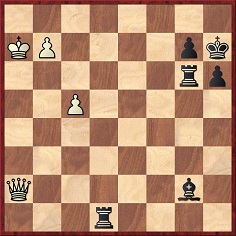
I. Leventić v J.P. Boudre, European Cup, Luxemburg, 1993
62 b8(N). The game was won by Black at move 81.
Source: Europe Echecs, November 1993, pages 19-20.
(2061)
Regarding the first position in C.N. 2061 above (Vujić v Petrović, Yugoslav Ladies’ Championship, 1985), Emil Smilovici (Nepean, Ontario, Canada) asks whether the full game-score is available.
We can offer only the remaining moves, as published by Tim Krabbé in the source indicated in the earlier C.N. item (New in Chess, November 1985, page 57):

74 f8(N) Ne4 75 Ne6+ Kb7 76 Kf7 Ka6 77 Nd4 Kb7 78 Ke7 Nc5 79 Nf7 Kc7 80 Nfd6 Na4 81 N6b5+ Kb7 82 Kd8 Nc5 83 Nbd6+ Ka7 84 Kc8 Nd3 85 Nc6+ Ka6 86 Nb8+ (86 Kb8 mates one move earlier.) 86...Ka7 87 Nb5+
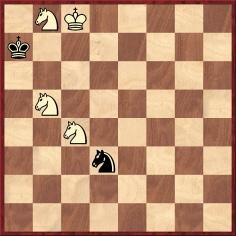
‘and Black resigned; the next move would be mate’.
(8124)
A large number of specimens of knight promotion without check were given by René Olthof in an article entitled ‘Silicon Curiosities’ on pages 80-83 of the 4/1994 New in Chess.
Julián Alonso Martín (Seville, Spain) forwards us the following position from a 1985 correspondence game between Palevich and Lebelt:
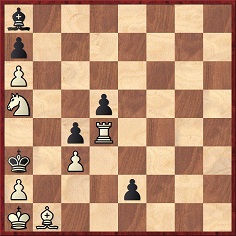
Play went: 1 Nxc4+ dxc4 2 Rd1 exd1(N) 3 Be4 Nxc3 4 Bxa8 Nxa2 5 Bd5 c3 6 Bxa2 c2 7 Bbl Drawn.
The above was published on page 29 of issue 1 of the ‘Especial’ edition of Ocho x Ocho. We should like further details.
(2068)
Jerky Konikowski (Dortmund, Germany) proposes an alternative way for White to draw in the above Palevich v Lebelt position: 1 Rxc4 e1(Q) (1...dxc4 2 Nxc4+ Ka4 3 Nb2+, followed by 4 Nd3.) 2 Rc5 Qe2 (against the threat of 3 Nc4+ and 4 Ra5 mate) 3 Nc4+ Qxc4 4 Ra5+ Qa4 5 Rxa4+ Kxa4 6 Kb2 Kb5.
He also reports that the Palevich v Lebelt position inspired him to compose the following ending, which was published in the 12/1986 issue of Schach-Echo, as well as on page 260 of Schachspiegel 2/1992:

White to move and win
Solution: 1 e7 a1(Q) 2 Bxa1 Rd8 3 exd8(N) Be5 4 Nxc6 Bxa1 5 Nxa7 Bd4 6 Nc8 Bxc5 7 Nb6+ Bxb6 8 axb6 Kb8 9 b7 Kc7 10 Ka7 and wins.
(2112)
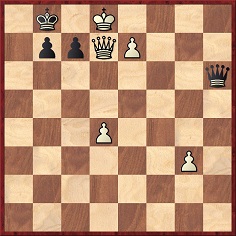
N.N. v F. Präger, (Venue?), February 1924
There followed 1…Qh8+ 2 e8(Q) Qf6+ Drawn. White could have won with 2 e8(N).
Source: Tijdschrift van den Nederlandschen Schaakbond, December 1929, page 395.
(2517)
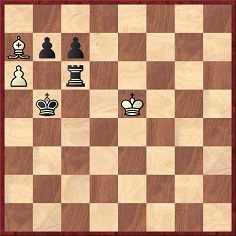
A position (White to move) from a game at the Café Kaiserhof, Berlin, which was passed on by Jacques Mieses. Play went 1 axb7 Re6+ 2 Kxe6 Kc6 Drawn.

Source: Deutsches Wochenschach, 24 January 1897, page 32.
(Kingpin, 1994)
We gave the following footnote on page 27 of Kings, Commoners and Knaves:
A similar position had already appeared on page 212 of the July 1895 Deutsche Schachzeitung as a study by Troitzky, but with the action in the ‘North East’ part of the board. See also page 26 of A.J. Roycroft’s Test Tube Chess (and the revised edition thereof, The Chess Endgame Study), which placed Troitzky’s study in the ‘South East’. To complete the tour, page 85 of T. Schuster’s Wenn Sie am Zuge wäre ...? put the play in the ‘South West’ sector. We cannot think of any other position which has been published in all four quandrants.
Concerning the second position, on 20 October 2000 Adri Plomp (Hilversum, the Netherlands) informed us that the game was played in the Dutch national championship held in Amsterdam from 24 July to 2 August 1924 (see page 316 of the Dutch magazine which was our source).
A complex game with underpromotion and a strange king march was given in C.N. 2353:
Häfner – L. Herrmann
Dortmund, 1937
Nimzo-Indian Defence
1 d4 Nf6 2 c4 e6 3 Nc3 Bb4 4 Qc2 Nc6 5 Nf3 d6 6 Bg5 h6 7 Bxf6 Qxf6 8 e3 O-O 9 Bd3 e5 10 d5 Nb8 11 O-O Bxc3 12 Qxc3 Qe7 13 Nd2 f5 14 f4 Nd7 15 Rae1 e4 16 Bc2 a5 17 Nb3 a4 18 Nd4 Nf6 19 b4 axb3 20 axb3 Bd7 21 Ra1 c5 22 dxc6 bxc6 23 b4 Kh7 24 h3 Nh5 25 Kh2 g5 26 Rxa8 Rxa8 27 g4 fxg4 28 fxg5 Qe5+ 29 Kg1 Qg3+ 30 Kh1 Qxh3+ 31 Kg1 Ng3 32 Rf7+ Kg8 33 Rg7+ Kh8 34 Rf7 Ra1+ 35 Qxa1 Qh1+ 36 Kf2 Qxa1 37 Rxd7 Nh5 38 Bxe4 g3+ 39 Ke2 Qb2+ 40 Kf3 g2 41 Ne6
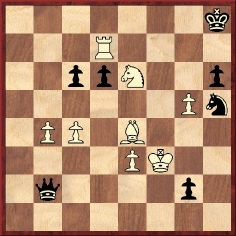
41…g1(N)+ 42 Kg4 Qe2+ 43 Kf5 Ng3+ 44 Kf6 Nxe4+ 45 Kg6 Nf6 46 gxf6 Qg4+ 47 Kf7 h5 48 Nf8 Nf3 49 Ke8 Ne5 50 Rh7+ Kg8 51 Rg7+ Qxg7 52 fxg7 h4 53 Nh7 h3 54 Nf6+ Kxg7 55 Nh5+ Kh6 56 Ng3 Drawn (although the endgame is a win for Black).
Source: Deutsche Schachblätter, 15 November 1937, pages 346-348.
A famous instance of early under-promotion is 1 e4 e5 2 f4 exf4 3 b3 Qh4+ 4 g3 fxg3 5 h3 g2+ 6 Ke2 Qxe4+ 7 Kf2 gxh1(N) mate (‘N.N.- A. Goetz, Strasbourg, 1880’).
Alphonse Goetz (1865-1934) published the score in an autobiographical article on page 162 of the 22nd issue of Les Cahiers de L’Echiquier Français, i.e. about 50 years later. The narrative indicates that the game was played around 1880 (which means that Goetz was aged about 15). White was identified only as ‘M.B.’, a condisciple who died prematurely. Goetz appended question marks to White’s third and fifth moves and merely remarked after 5 h3, ‘Black mated in three moves’, without specifying the under-promotion finish.
A curiosity is that page 43 of Le Guide des échecs by N. Giffard and A. Biénabe (Paris, 1993) identified White as ‘Wiede’.
The same combination has been seen with colours reversed:
Dr Reinle – N.N.
Occasion?
King’s Gambit Declined
1 e4 e5 2 f4 f5 3 exf5 e4 4 Qh5+ g6 5 fxg6 h6 6 g7+ Ke7 7 Qe5+ Kf7 8 gxh8(N) mate.
Source: Deutsche Schachblätter, 15 May 1936, page 155. The magazine’s item, taken from the Mitteldeutsche Nazional-Zeitung, merely stated that the game had been ‘won recently by Dr Reinle of Murnau’.
(2553)
How does White mate in four moves from the position below?
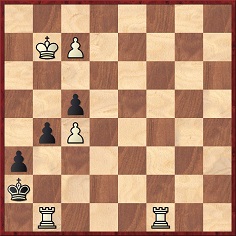
Solution: 1 c8(B) b3 2 Bg4 b2 3 Bd1 Kxb1 4 Bb3 mate.
Source: CHESS, January 1953, page 65, which merely intimated that the problem had been published in Munich circa 1908 and did not identify the composer.
(2811)
The problem was by Oswald von Krobshofer (1883-1960) and, according to secondary sources, was published in the Münchener Neueste Nachrichten in 1908. Our thanks to Ivo Fasiori (Prato, Italy), Michael McDowell (Westcliff-on-sea, England) and Graeme Oswald (Chester-le-Street, England) for this information.
(2817)
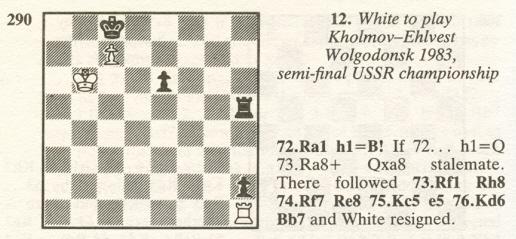
The above comes from page 186 of Chess Curiosities by Tim Krabbé, and Claus van de Vlierd (Oldenburg, Germany) asks whether the full game-score is available.
We note that various databases break off the Kholmov v Ehlvest game in this position, after 40...b5:
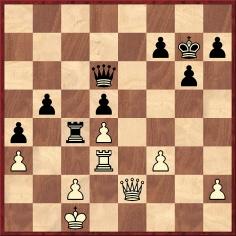
See also pages 916-917 of the October 1996 issue of EG, which states that the score only as far as move 42 was given in the 1/1984 issue of Shakhmatny byulleten.
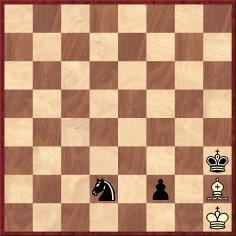
This position (White to move) was given on pages 262-263 of Combination in Chess by G. Négyesy and J. Hegyi (Budapest, 1965). It is described as ‘a possible subvariation’ from the game Haág v L. Szabó, Budapest, 1958, and the moves indicated are 1 Bg1 f1(B), and Black wins.
See also page 193 of Chess Curiosities by T. Krabbé:
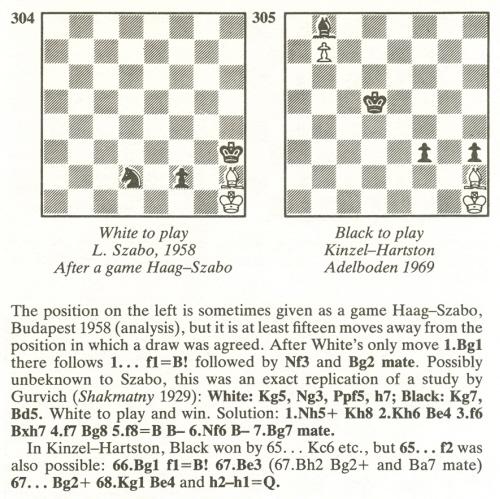
In databases the score of the Haág v Szabó game can be found as far ‘63 Ke3 Nxf6 0-1’:
1 e4 e5 2 Nf3 Nc6 3 d4 exd4 4 Nxd4 Bc5 5 Nb3 Bb4+ 6 c3 Be7 7 c4 Nf6 8 Nc3 Bb4 9 Bd3 a5 10 O-O a4 11 e5 Nxe5 12 Nd4 O-O 13 Bg5 Bxc3 14 bxc3 h6 15 Bh4 Ng6 16 Bg3 d6 17 Re1 Re8 18 Rxe8+ Nxe8 19 Rb1 Nf6 20 Bc2 a3 21 c5 dxc5 22 Nb5 Qxd1+ 23 Rxd1 Bd7 24 Nxc7 Rc8 25 c4 Nf8 26 Be5 Be6 27 Nxe6 Nxe6 28 Bf5 Ra8 29 Bc2 Rd8 30 Rxd8+ Nxd8 31 Bf4 Nc6 32 Bc1 Na5 33 Bxa3 b6 34 Bd3 Ne8 35 Bc1 Nd6 36 Kf1 Kf8 37 Ke2 Naxc4 38 Bxc4 Nxc4 39 Kd3 Nd6 40 a4 Ke7 41 Ba3 Kd7 42 f3 Kc6 43 g4 Kd5 44 Bb2 g6 45 Bg7 h5 46 h3 Nc4 47 Bf6 Ne5+ 48 Ke3 Nd7 49 Bd8 c4 50 a5 bxa5 51 Bxa5 Nc5 52 gxh5 gxh5 53 Bc3 Ne6 54 Bf6 Kc5 55 f4 Kd5 56 f5 Nc5 57 Ba1 Ne4 58 f6 c3 59 Kd3 Ke5 60 Ke3 Kf5 61 Kd3 Kf4 62 h4 Kf5 63 Ke3 Nxf6
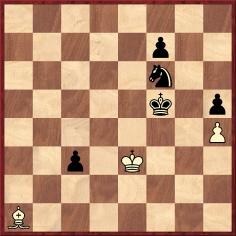
Is anything more known about the game’s conclusion?
(6514)
Michael McDowell points out that a miniature study by S.G. Belokon quoted on page 310 of Test Tube Chess by A.J. Roycroft (London, 1972) shows promotion to both knight and bishop and the same finish as in the Szabó position.
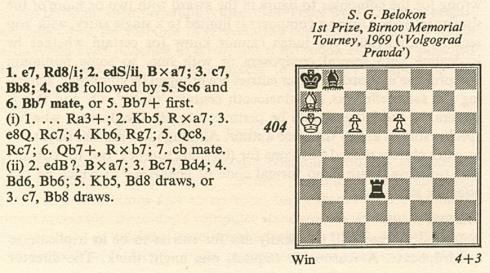
(6523)
In a letter on page 7 of the January 1937 Chess Review Herbert Harvey proposed a rule change whereby a pawn would ‘become by promotion automatically the piece appropriate to the file on which it is promoted’. A choice of pieces would exist only in case of promotion on the king’s file.
On page 29 of the following month’s issue Paul H. Litwinsky (later: Paul H. Little) related an ‘offhand remark’ by Capablanca at Nottingham, 1936, regarding stalemate:
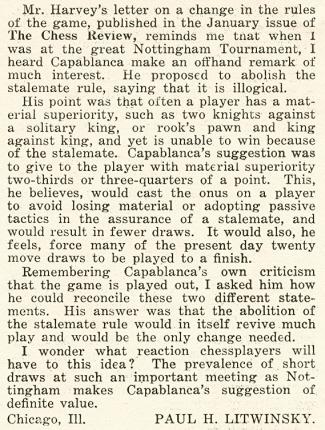
(7051)
A five-star book just published is The Art of the Endgame by Jan Timman (Alkmaar, 2011). Chapter five is entitled ‘Knight Promotions’, and we became particularly interested in the pair of compositions on pages 82-83:
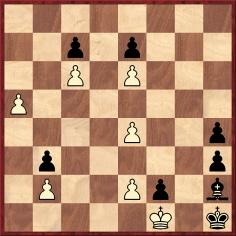
‘Herland, Deutsches Wochenschach, 1913. White to play and win’
1 a6 Bg1 2 a7 h2 3 a8(N) h3 4 Nb6 cxb6 5 c7 b5 6 c8(N) b4 7 Nd6 exd6 8 e7 d5 9 e8(Q) and wins.
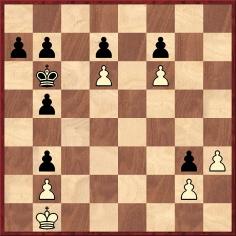
‘F. Fritz. White to play and win’
1 h4 Ka5 2 h5 Ka4 3 h6 b4 4 h7 b5 5 h8(N) a5 6 Ng6 fxg6 7 f7 g5 8 f8(N) g4 9 Ne6 dxe6 10 d7 e5 11 d8(N) and wins.
Regarding the latter composition, Timman commented:
‘It is unclear when this study was made. In the database it has been adorned with the label “source unknown”.
Who was F. Fritz? He should certainly not be mixed up with Jindřich Fritz ...’
The main historical issue raised by Timman is whether Sigmund Herland was the first to compose such a study, in 1913, or whether the Fritz position antedated it. We offer some jottings.
The Herland study was published on page 128 of the 6 April 1913 Deutsches Wochenschach, with the solution on page 247 of the 13 July 1913 issue.
We note furthermore that the endgame database of Harold van der Heijden has the following study by Hugo Geiger of Munich from page 38 of the February 1920 Deutsche Schachzeitung:
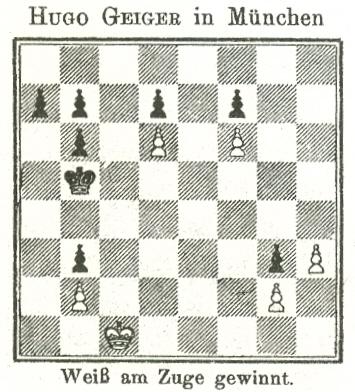
When the solution was given on page 139 of the June 1920 issue it was remarked that the third promotion to a knight was not necessary, because 11 d8(Q) would win too:

The Geiger position was also discussed, without identification of him, in T.R. Dawson’s ‘Endings’ column on page 218 of the May 1938 BCM:
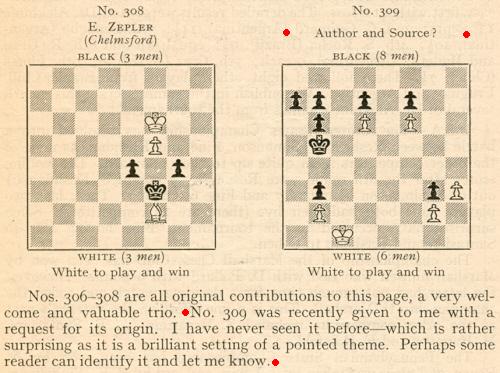
From page 262 of the June 1938 issue:
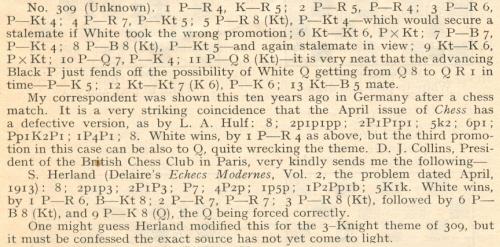
Dawson returned to the study on page 310 of the July 1938 BCM:

As regards the ‘fatal flaw’, the key point is whether the white king is on b1 or c1. The van der Heijden database has both versions, but who first proposed the improvement of placing the king on b1?
The position by L.A. Hulf which was mentioned by Dawson in the June 1938 BCM had appeared on page 299 of the 14 April 1938 CHESS, in Hulf’s ‘End Games’ column:
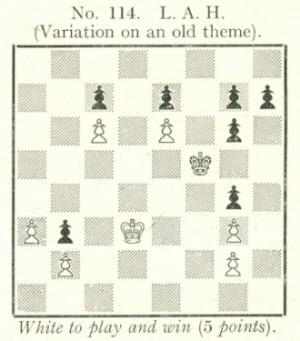
The solution was given on page 369 of the 14 June 1938 issue:
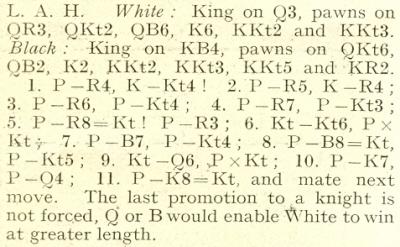
(7418)

Harold van der Heijden (Deventer, the Netherlands) answers the question in C.N. 7418 about who proposed the improvement (white king on b1, and not c1) in this study from page 38 of the February 1920 Deutsche Schachzeitung: Mikhail Zinar (Ukraine), on page 137 of a book co-written with Vladimir Archakov: Гармония Пешечного Этюда (Kiev, 1990).
(10036)
Steven B. Dowd (Birmingham, AL, USA) notes that the knight promotion motif was used in a composition by Donald H. Hersom in the 10/1936 Fairy Chess Review. It can be found on-line by copying PROBID='P0553007' into the search-box of the Schwalbe website.
(7435)
From Robert John McCrary (Columbia, SC, USA):
‘What is the simplest or most sparse legal position, in terms of number of units and strength of material, in which the only winning move is promotion to a bishop? In 1969 I composed this pair of positions:
White wins with 1 b8(B). If 1 b8(N) Nf7+ 2 Kg6 Ng5.
Again, promoting to a bishop is the only winning move, although the defenses are different (beginning with 1...Ne7+ 2 Kf6 Kh7).
A related question concerns the simplest or most sparse legal position in which promotion to a bishop is the only way to draw (by self-stalemate.)’
(7950)
1 e4 e5 2 Bc4 Nf6 3 Nf3 Nc6 4 Ng5 d5 5 exd5 Na5 6 Bb5+ c6 7 dxc6 bxc6 8 Be2 h6 9 Nf3 e4 10 Ne5 Qd4 11 Ng4 Bxg4 12 Bxg4 e3 13 f3 h5 14 Bh3 Qh4+ 15 Ke2 Qf2+ 16 Kd3 Rd8+ 17 Kc3 e2 18 Qg1 Nd5+ 19 Kd3 Ne3+ 20 Kc3 Qxg1 21 Rxg1 Nd1+ 22 Rxd1
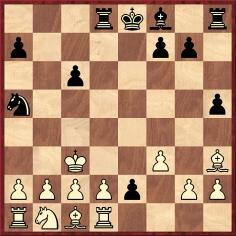
22...exd1(N) mate.
This familiar game is generally said to have been won by J.W. Showalter against A.H. Robbins in Lexington in 1910; see, for example, pages 442-443 of 1000 Best Short Games of Chess by Irving Chernev (New York, 1955).
Eduardo Bauzá Mercére (New York, NY, USA) informs us that it was played in the United States Chess Association championship in St Louis in February 1890 and that the score was published on page 5 of the Albany Evening Journal, 21 June 1890:
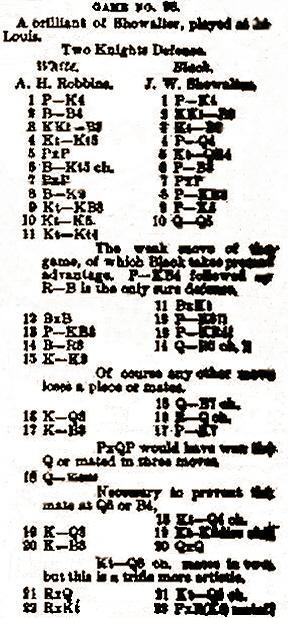
(8038)
In an interview with Martijn Smit on pages 6-8 of the 4/1984 New in Chess Tony Miles said:
‘... I have a strong tendency to look at crazy things first. When promoting a pawn I prefer a bishop to a queen if that is possible ... I am very fond of, let us say, three rooks on the board. In a weekend tournament I had that once, and instead of resigning my opponent allowed himself to be mated beautifully, in the middle of the board. That appeals to me.’
The comments were reproduced on page 22 of Tony Miles: ‘It’s Only Me’ compiled by Geoff Lawton (London, 2003). Is the three-rook game extant?
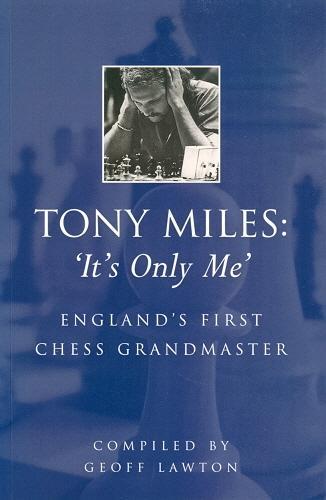
(8247)
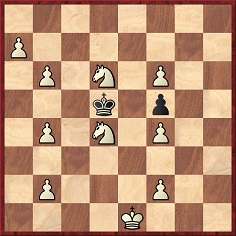
White mates in two moves
The solution is 1 a8(R). If 1...Kxd6, 2 Rd8 mate, and if 1...Kxd4 then 2 O-O-O mate.
The latter line depends on a perceived flaw in the chess laws of the time (Article 8). The problem, by Jose Benardete [sic] and Edgar Holladay, was published on page 2 of Chess Life, 20 October 1949. It was given too on page 46 of Chess World, 1 February 1950:
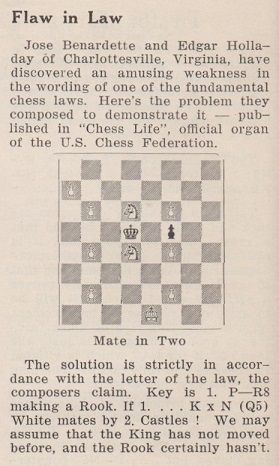
(9300)
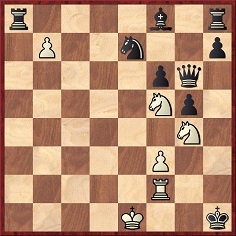
White to move and mate in two
One of our feature articles on the Laws of Chess mentioned that the ‘International Chess Code’ was published, inter alia, on pages 207-224 of Chess for Fun & Chess for Blood by Edward Lasker (Philadelphia, 1942). An extract from the provisions on castling (pages 212-213):
‘The king can be moved to a square adjoining the square he occupies except in the case of castling, which is a combined move of the K and the R, but counts as one move, in which first the K, occupying his own square, is placed on one of the two nearest squares of the same color as his own in the same rank and then the R, towards which the K has been moved, is placed on the next square on the further side of the moved K. Castling is not permitted (a) when either the K or R has been moved previously; (b) when any square between the K and the R is occupied by a man; (c) if the K be in check; or (d) if castling would cause the K to pass over, or occupy, any square on which he would be in check.’
The above position was presented by Jack Straley Battell on page 33 of the February 1955 Chess Review:
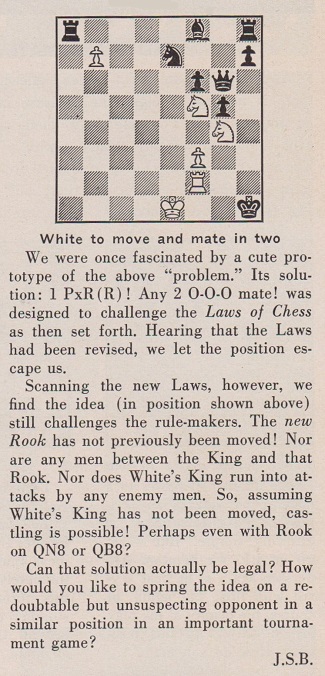
Where did the problem originate?
(10198)
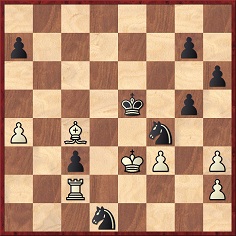
Position after 39...d1(N) mate.
That was the conclusion of a game won by Soldatenkov against C.P. Weeks which has been found by Eduardo Bauzá Mercére in the Brooklyn Daily Eagle, 24 March 1921, Section 1, page 3:
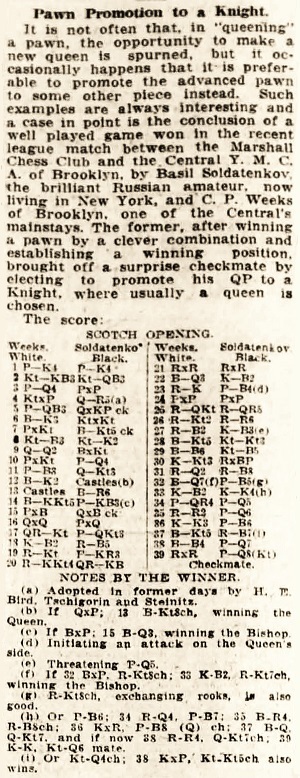
1 e4 e5 2 Nf3 Nc6 3 d4 exd4 4 Nxd4 Qh4 5 c3 Qxe4+ 6 Be3 Nxd4 7 cxd4 Bb4+ 8 Nc3 Ne7 9 Qd2 Bxc3 10 bxc3 d5 11 f3 Qg6 12 Be2 O-O 13 O-O Bh3 14 Bg5 f6 15 gxh3 Qxg5+ 16 Qxg5 fxg5 17 Rab1 b6 18 Kf2 Rf4 19 Rg1 h6 20 Rg4 Raf8 21 Rxf4 Rxf4 22 Bd3 Kf7 23 Re1 c5 24 dxc5 bxc5 25 Rb1 Ra4 26 Rb2 Ra3 27 Rc2 Kf6 28 Bb5 Ng6 29 Bc6 Nf4 30 Kg3 Rxc3 31 Rd2 Rc1 32 Bd7 c4 33 Kf2 Ke5 34 a4 d4 35 Ra2 d3 36 Ke3 c3 37 Bb5 Rc2 38 Bc4
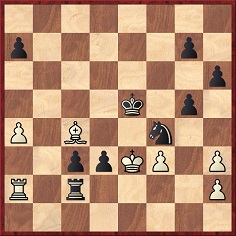
38...d2 39 Rxc2 d1(N) mate.
(10373)
Regarding the famous Saavedra position, see pages 34-35 of Kings, Commoners and Knaves and C.N. 5796.
To the Chess Notes main page.
To the Archives for other feature articles.
Copyright: Edward Winter. All rights reserved.